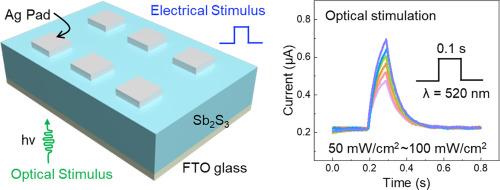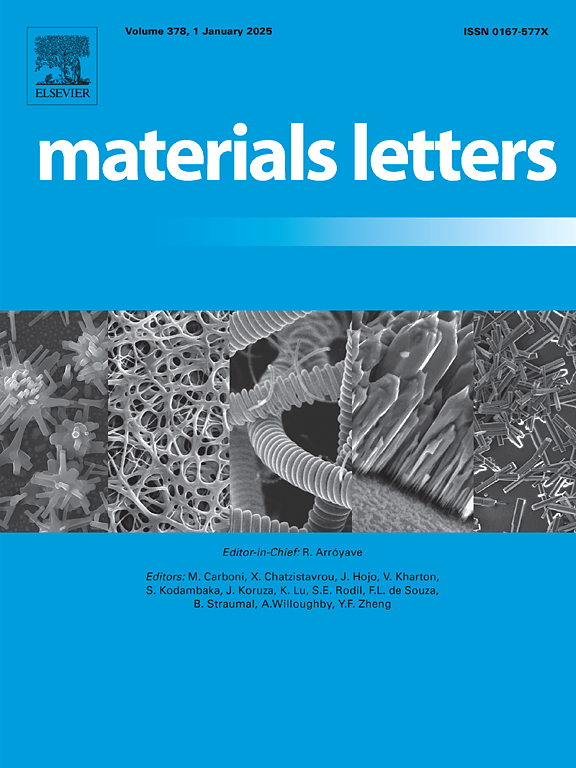Electrical-optical dual-modulated synaptic memristor based on thermal evaporated Sb2S3 thin film
IF 2.7
4区 材料科学
Q3 MATERIALS SCIENCE, MULTIDISCIPLINARY
引用次数: 0
Abstract
The optoelectronic memristors (OMs), capable of simultaneous response to electrical and optical stimuli, have emerged as promising components for constructing neuromorphic computing and artificial visual systems. To pursue such devices, novel materials with stable electrical properties and a suitable bandgap responsive to the visible light spectrum are in urgent demand. Antimony sulfide (Sb2S3) shows great potential considering its excellent stability, earth-abundance, high light absorption coefficients, and optimal bandgap of ∼1.7 eV. Here, we report OMs based on the Sb2S3 thin film deposited via the industrially compatible thermal evaporation technique. With an FTO/ Sb2S3/Ag structure, the devices demonstrate reliable resistive switching and robust endurance. Typical synaptic functions, such as the excitatory postsynaptic current (EPSC) and paired-pulse facilitation (PPF) characteristics, are successfully mimicked. These results highlight the significant potential of integrating Sb2S3 OMs into artificial intelligence hardware.

基于热蒸发Sb2S3薄膜的电光双调制突触忆阻器
光电忆阻器(OMs)能够同时响应电和光刺激,已成为构建神经形态计算和人工视觉系统的重要组成部分。为了实现这种器件,迫切需要具有稳定电性能和对可见光光谱响应的合适带隙的新型材料。考虑到硫化锑(Sb2S3)优异的稳定性、丰度、高光吸收系数和约1.7 eV的最佳带隙,它显示出巨大的潜力。在这里,我们报告了基于Sb2S3薄膜的OMs,通过工业兼容的热蒸发技术沉积。该器件采用FTO/ Sb2S3/Ag结构,具有可靠的电阻开关和耐用性。典型的突触功能,如兴奋性突触后电流(EPSC)和成对脉冲促进(PPF)特征,被成功地模仿。这些结果突出了将Sb2S3 OMs集成到人工智能硬件中的巨大潜力。
本文章由计算机程序翻译,如有差异,请以英文原文为准。
求助全文
约1分钟内获得全文
求助全文
来源期刊

Materials Letters
工程技术-材料科学:综合
CiteScore
5.60
自引率
3.30%
发文量
1948
审稿时长
50 days
期刊介绍:
Materials Letters has an open access mirror journal Materials Letters: X, sharing the same aims and scope, editorial team, submission system and rigorous peer review.
Materials Letters is dedicated to publishing novel, cutting edge reports of broad interest to the materials community. The journal provides a forum for materials scientists and engineers, physicists, and chemists to rapidly communicate on the most important topics in the field of materials.
Contributions include, but are not limited to, a variety of topics such as:
• Materials - Metals and alloys, amorphous solids, ceramics, composites, polymers, semiconductors
• Applications - Structural, opto-electronic, magnetic, medical, MEMS, sensors, smart
• Characterization - Analytical, microscopy, scanning probes, nanoscopic, optical, electrical, magnetic, acoustic, spectroscopic, diffraction
• Novel Materials - Micro and nanostructures (nanowires, nanotubes, nanoparticles), nanocomposites, thin films, superlattices, quantum dots.
• Processing - Crystal growth, thin film processing, sol-gel processing, mechanical processing, assembly, nanocrystalline processing.
• Properties - Mechanical, magnetic, optical, electrical, ferroelectric, thermal, interfacial, transport, thermodynamic
• Synthesis - Quenching, solid state, solidification, solution synthesis, vapor deposition, high pressure, explosive
 求助内容:
求助内容: 应助结果提醒方式:
应助结果提醒方式:


